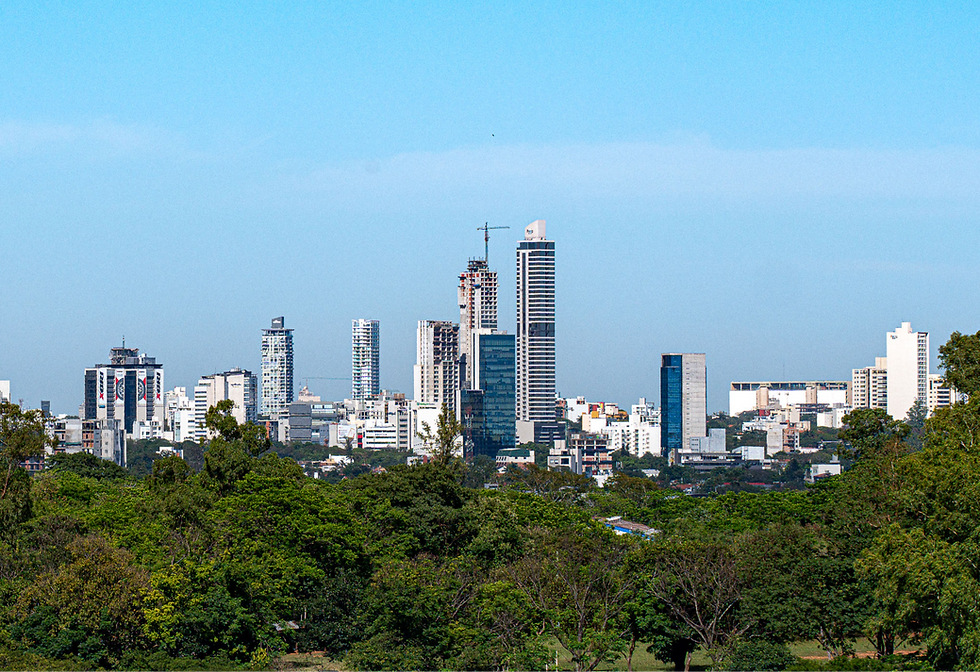Distrito Norte: The Association That Is Promoting Urban Infrastructure in Northern Asunción
- Carlos E. Gimenez

- Jun 26
- 5 min read
Updated: Jul 3
An alliance between developers, educators, and commercial operators seeks to transform the Luque–Mariano–Limpio corridor into a new planned urban axis, integrating infrastructure, services, and community from a shared vision.
.

As population growth and real estate expansion continue to advance steadily in the municipalities of Luque, Mariano Roque Alonso, and Limpio, a group of developers decided not only to accompany the phenomenon, but to anticipate its consequences. Within the framework of the Paraguay 2025 Real Estate Expo, the Asociación Distrito Norte (Northern District Association) was publicly presented. This non-profit organization is comprised of key private sector players who, rather than competing alone, chose to collaborate in the creation of a new metropolitan center north of Asunción.
Distrito Norte is not a real estate development, nor a gated community with cohabitation rules; it's a shared vision of how to organize and enhance a region undergoing transformation. Its origins date back to a series of informal conversations between companies such as Altamira Group, Altius Group, Raíces Real Estate, Penta, and representatives from Maple Bear School. All of them operated in the same region, often with similar real estate products. But as they observed the simultaneous growth of their projects, they realized that the real challenge wasn't selling units, but building an integrated urban ecosystem.
The diagnosis was clear: the northern corridor of the Asunción metropolitan area experienced some of the highest growth rates in the country, but faced severe limitations in infrastructure, road connectivity, basic services, access to healthcare, education, and urban facilities. Local authorities, while aware of the need to intervene, operated with budgetary constraints that made any type of large-scale urban planning unfeasible.
Faced with this reality, the Northern District Association was established with a strategic objective: to align the efforts of the private sector, coordinate dialogue with the public sector, and anticipate—through investment and planning—the necessary conditions to consolidate a habitable, inclusive, and functional territory. The scale of this commitment is significant: the association's members are already planning more than 6,000 housing units and an estimated investment volume of $1.5 billion.
One of the distinctive elements of Distrito Norte is its holistic approach. Rather than simply developing isolated gated communities, its members promote territorial planning that considers not only housing but also everyday life. This involves integrating educational centers, medical institutions, commercial spaces, entertainment areas, sports facilities, and even transportation and job training solutions from the outset. The aspiration is not to build commuter towns, but rather complete urban environments where time—the true luxury of our times—can be lived to the fullest.
In this regard, one of the most significant milestones was the establishment of Maple Bear School in Surubi'i, a strategic decision that responded to a specific demand: families wouldn't move to the area if they didn't have quality educational opportunities for their children. Based on this logic, new alliances emerged, residential projects were consolidated, and commercial spaces were designed with an experiential focus, breaking the traditional mold of the shopping center as a container for stores to focus on vibrant urban centers with gastronomy, culture, entertainment, and services.
The collaborative vision is not limited to the design of private spaces. In recent years, the Association has also promoted direct initiatives to accelerate public infrastructure projects. A landmark example is the expansion of Route 025—a key access road to the International Airport—whose engineering project was donated by Association members, allowing the State to quickly tender the project without delays in the technical processes. Similarly, new road connections are being planned, such as the corridor that will link Route 025 with the city of Limpio.
The model is also distinguished by its relationship with the public sector. Aware of the fiscal and administrative constraints facing municipalities, the Association adopted a proactive approach to accelerate key projects. A concrete example was the duplication of Route 025, an essential artery for access to the airport. Rather than wait years for state bidding processes, members donated the technical design of the project, allowing the government to quickly begin its execution. This same model is now being repeated with new road connections that seek to integrate Limpio with the main corridor and decompress the existing network.
Private contributions to public works mark a shift in the traditional logic of urban development in Paraguay. It is no longer simply a matter of meeting minimum municipal requirements, but rather of collectively investing in structural works that benefit both private projects and neighboring communities. This coordination is also a way to mitigate historical asymmetries, where gated communities coexisted with slums without access to drinking water, public lighting, or basic services.
From the perspective of those leading the project, the priority is to build a balanced urban environment, where those who live in gated communities share territory with those who provide services, work in businesses, teach in schools, or care for children. Inclusion, in this sense, is not an afterthought, but a principle of urban sustainability. Housing, businesses, schools, clubs, and public spaces must be conceived together, as part of a whole, not as individual pieces of a model.
This vision is also supported by regional precedents. One of the group's leaders recounted his experience in Pilar, north of Buenos Aires, where in the 1990s a similar model of articulated suburban development transformed a semi-rural area into a true urban cluster with universities, hospitals, corporate offices, and an integrated network of residential neighborhoods. The key, he recalled, was always the same: infrastructure, coordination, and a shared vision.
The Paraguayan case, however, has its own particularities. In a country where urban planning is still in its infancy and regulatory frameworks are evolving, projects like Distrito Norte challenge traditional ways of building cities. They do so from the private sector, but with an explicit public focus. And they do so with a clear openness to new additions. The founding group is not conceived as a closed circle, but rather as an initial core willing to integrate other actors, including developers, educational institutions, sports clubs, healthcare providers, and logistics services.
The scale of the impact is already tangible. New commercial centers are being developed, such as Plaza Norte in Limpio, and mixed-use complexes are planned in Mariano Roque Alonso. The coordination between actors also occurs at the level of alliances: companies that were once direct competitors are now becoming partners in shopping centers, road infrastructure, or the planning of shared service nodes.
Looking ahead, the vision is even more ambitious. The goal is to consolidate a decentralized, connected, multifunctional, and sustainable metropolitan hub. A place where living means more than just owning a house; it means inhabiting a complete environment, with real opportunities for education, healthcare, work, and recreation. A place where new developments don't displace existing communities, but rather integrate, listen to, and strengthen them.
Ultimately, Distrito Norte represents a new model of urban planning in Paraguay. One that doesn't depend exclusively on the state, but neither does it replace it. One that doesn't respond solely to the logic of economic return, but neither does it ignore it. One that is committed to a more mature, more collaborative, and, above all, more coherent urban development with the country we want to build. A country where growth is not synonymous with sprawl, but with intelligent and shared integration.


